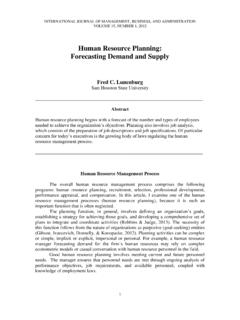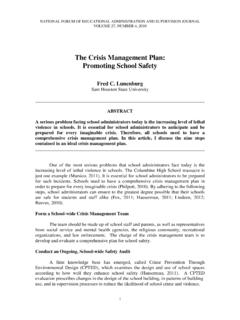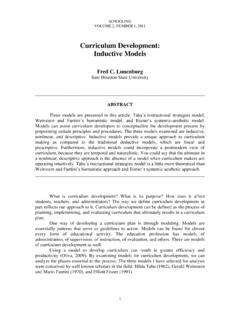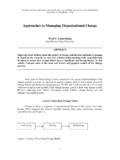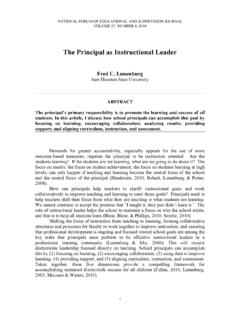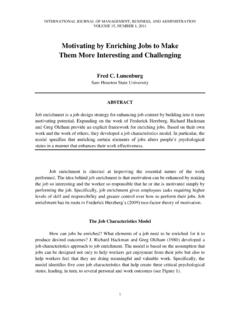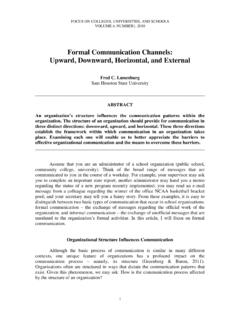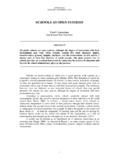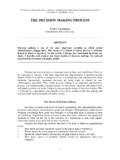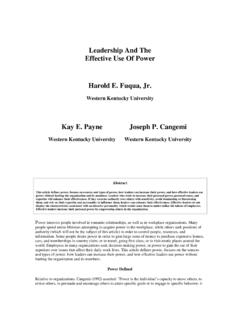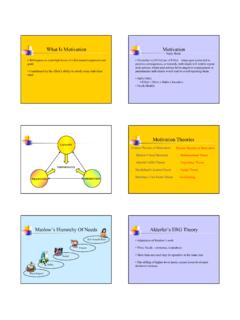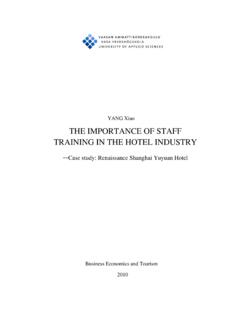Transcription of Expectancy Theory of Motivation: Motivating by Altering ...
1 INTERNATIONAL JOURNAL OF MANAGEMENT, BUSINESS, AND ADMINISTRATION VOLUME 15, NUMBER 1, 2011 1 Expectancy Theory of Motivation: Motivating by Altering Expectations Fred C. Lunenburg Sam Houston State University _____ ABSTRACT Vroom s Expectancy Theory differs from the content theories of Maslow, Alderfer, Herzberg, and mcclelland in that Vroom s Expectancy Theory does not provide specific suggestions on what motivates organization members. Instead, Vroom s Theory provides a process of cognitive variables that reflects individual differences in work motivation. From a management standpoint, the Expectancy Theory has some important implications for Motivating employees.
2 It identifies several important things that can be done to motivate employees by Altering the person s effort-to-performance Expectancy , performance-to-reward Expectancy , and reward valences. _____ Need theories of motivation (Alderfer, 1972; Herzberg, 1968; Maslow, 1970; mcclelland , 1976) attempt to explain what motivates people in the workplace. Expectancy Theory is more concerned with the cognitive antecedents that go into motivation and the way they relate to each other. That is, Expectancy Theory is a cognitive process Theory of motivation that is based on the idea that people believe there are relationships between the effort they put forth at work, the performance they achieve from that effort, and the rewards they receive from their effort and performance.
3 In other words, people will be motivated if they believe that strong effort will lead to good performance and good performance will lead to desired rewards. Victor Vroom (1964) was the first to develop an Expectancy Theory with direct application to work settings, which was later expanded and refined by Porter and Lawler (1968) and others (Pinder, 1987). Expectancy Theory is based on four assumptions (Vroom, 1964). One assumption is that people join organizations with expectations about their needs, motivations, and past experiences. These influence how individuals react to the organization.
4 A second assumption is that an individual s behavior is a result of conscious choice. That is, people are free to choose those behaviors suggested by their own Expectancy calculations. A third assumption is that people want different things from the organization ( , good INTERNATIONAL JOURNAL OF MANAGEMENT, BUSINESS, AND ADMINISTRATION 2_____ salary, job security, advancement, and challenge). A fourth assumption is that people will choose among alternatives so as to optimize outcomes for them personally. The Expectancy Theory based on these assumptions has three key elements: Expectancy , instrumentality, and valence.
5 A person is motivated to the degree that he or she believes that (a) effort will lead to acceptable performance ( Expectancy ), (b) performance will be rewarded (instrumentality), and (c) the value of the rewards is highly positive (valence). (See Figure 1.) Figure 1. Basic Expectancy model. Expectancy Expectancy is a person s estimate of the probability that job-related effort will result in a given level of performance. Expectancy is based on probabilities and ranges from 0 to 1. If an employee sees no chance that effort will lead to the desired performance level, the Expectancy is 0.
6 On the other hand, if the employee is completely certain that the task will be completed, the Expectancy has a value of 1. Generally, employee estimates of Expectancy lie somewhere between these two extremes. Instrumentality Instrumentality is an individual s estimate of the probability that a given level of achieved task performance will lead to various work outcomes. As with Expectancy , instrumentality ranges from 0 to 1. For example, if an employee sees that a good performance rating will always result in a salary increase, the instrumentality has a value of 1. If there is no perceived relationship between a good performance rating and a salary increase, then the instrumentality is 0.
7 Expectancy Effort Performance Rewards Instrumentality Valence FRED C. LUNENBURG _____3 Valence Valence is the strength of an employee s preference for a particular reward. Thus, salary increases, promotion, peer acceptance, recognition by supervisors, or any other reward might have more or less value to individual employees. Unlike Expectancy and instrumentality, valences can be either positive or negative. If an employee has a strong preference for attaining a reward, valence is positive. At the other extreme, valence is negative. And if an employee is indifferent to a reward, valence is 0.
8 The total range is from -1 to +1. Theoretically, a reward has a valence because it is related to an employee s needs. Valence, then, provides a link to the need theories of motivation (Alderfer, Herzberg, Maslow, and mcclelland ). Vroom suggests that motivation, Expectancy , instrumentality, and valence are related to one another by the equation Motivation = Expectancy x Instrumentality x Valence. The multiplier effect in the equation is significant. It means that higher levels of motivation will result when Expectancy , instrumentality, and valence are all high than when they are all low.
9 The multiplier assumption of the Theory also implies that if any one of the three factors is zero, the overall level of motivation is zero. Therefore, for example, even if an employee believes that his/her effort will result in performance, which will result in reward, motivation will be zero if the valence of the reward he/she expects to receive is zero ( if he/she believes that the reward he/she will receive for his/her effort has no value to him/her. Expectancy Theory in Practice: Key Managerial Implications Expectancy Theory has some important implications for Motivating employees.)
10 The model provides guidelines for enhancing employee motivation by Altering the individual s effort-to-performance Expectancy , performance-to-reward Expectancy , and reward valences. Several practical implications of Expectancy Theory are described next (Greenberg, 2011; Hellriegel & Slocum, 2011; McShane & Von Glinow, 2011; Nadler & Lawler, 1983). Effort-to-Performance Expectancy Leaders should try to increase the belief that employees are capable of preforming the job successfully. Ways of doing this include: select people with the required skills and knowledge; provide the required training and clarify job requirements; provide sufficient time and resources; assign progressively more difficult tasks based on training; follow employees suggestions about ways to change their jobs; intervene and attempt to alleviate problems that may hinder effective performance; provide examples of employees who have mastered the task; and provide coaching to employees who lack self-confidence.
